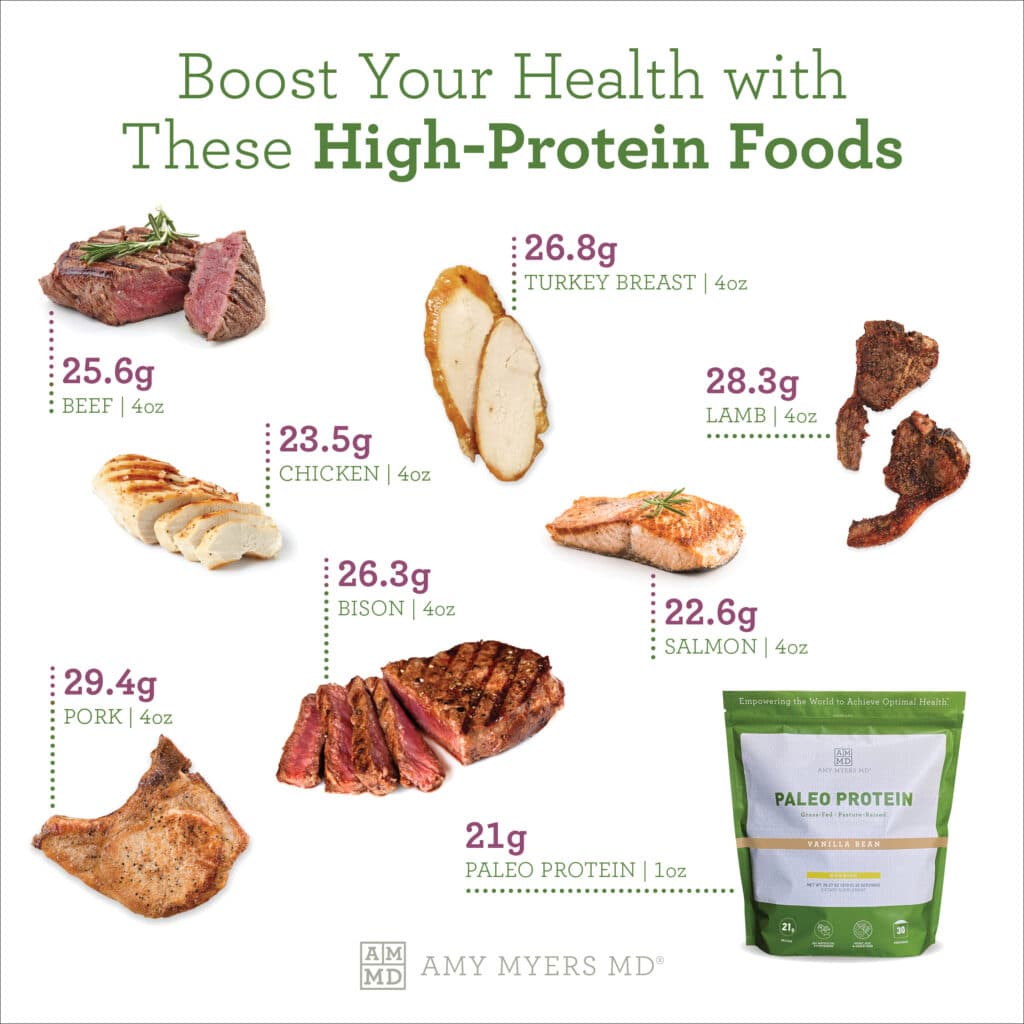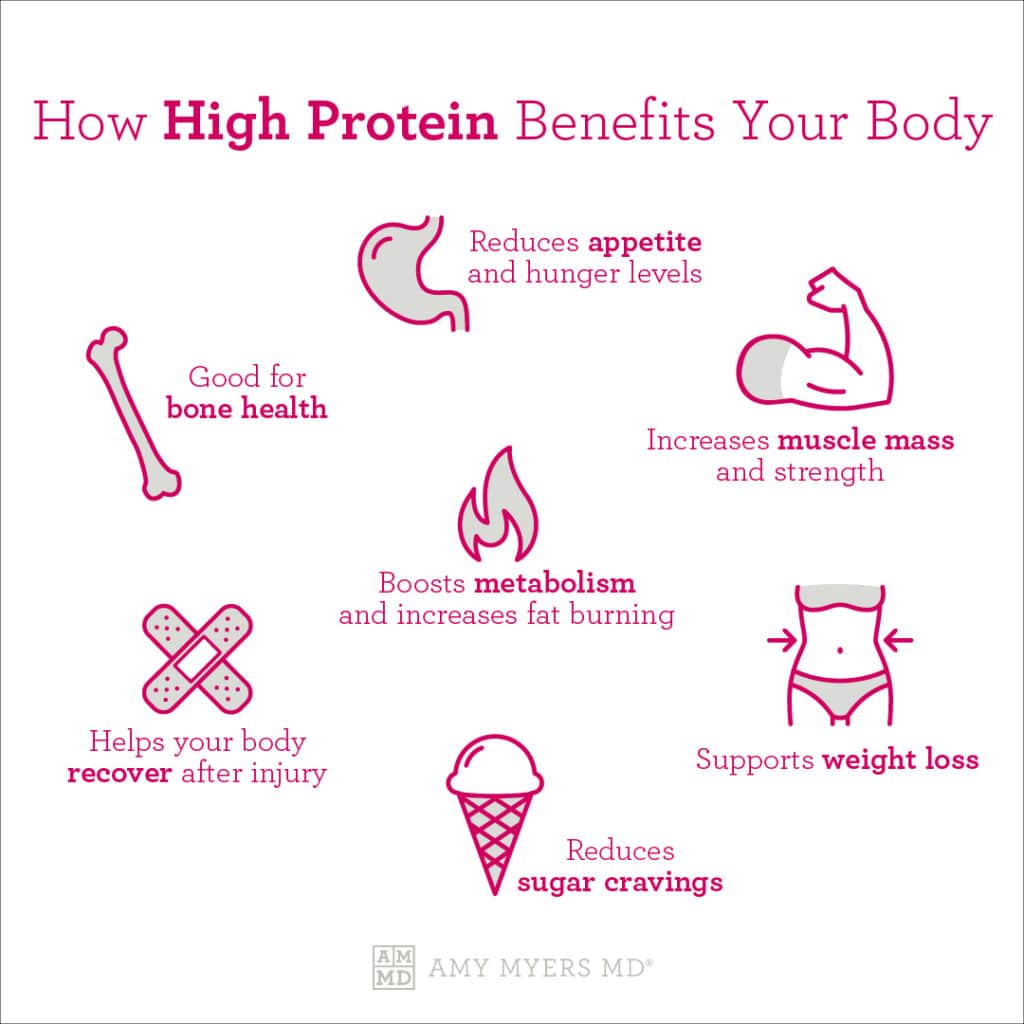Eating a diet full of high protein foods can feel impossible. The unfortunate truth is that you could eat high protein foods for every meal, and you likely still aren’t getting enough of this essential macronutrient because your body needs such large amounts of it for optimal health.
Protein is vital to your health! Your body needs protein intake to perform many functions, from growing and repairing its own tissues to supplying your body with energy. It’s even vital for weight loss.
As a macronutrient, your body needs high protein amounts to give it structure.1 How much protein you need to eat depends on various factors, such as your basal metabolic rate and activity levels. Unlike fat, another macronutrient, your body doesn’t have protein stores, so you need to consume it daily.
The good news is there are several delicious ways to incorporate protein into your diet. I will tell you about the benefits of protein, the difference between a complete protein and an incomplete protein, and how to determine how much protein you need. First, let’s talk about foods that are high in protein.
Foods High in Protein
The best source of protein is animal protein. Here’s why: Your body builds protein from 20 different amino acids. Your body can make some of these amino acids on its own, such as glycine, glutamine, and arginine, and these are known as nonessential amino acids.
Nine amino acids are needed to build protein that your body can only get from food sources, such as lysine and threonine, which build collagen. These are known as essential amino acids.
Animal protein contains all nine essential amino acids, while plant-placed proteins such as legumes, grains, nuts, and soy may have some amino acids yet may lack others. Also, grains contain gluten, which is inflammatory for many people and leads to leaky gut, while some people are sensitive to soy, legumes, and nuts. Follow an elimination diet to determine if you are sensitive to soy, legumes, or nuts.
The best food for protein is pork, which contains 29.4 grams of protein in one 4-ounce serving. Lamb, turkey, and bison also contain high amounts of protein. One 4 oz serving of lamb provides 28.3g of protein, while 4 oz of turkey contains 26.8g, and bison contains 26.3 grams.
Chicken (23.5 g/4 ounces), beef (25.6g), and salmon (22.6g) also contain high amounts of protein. You won’t get this high protein amount in non-animal foods. For example, a half-cup of chickpeas contains 7.25 grams of protein. Nuts and nut butter are rich in protein, yet many contain added sugars or cause sensitivities in people. Peanuts contain 20 grams per half-cup, while almonds offer 16.5g per half-cup. Regarding plant protein vs. animal protein, animal protein is the clear winner!
 Dr. Amy Myers
February 14th, 2023
https://content.amymyersmd.com/article/high-protein/high protein – infographic – Amy Myers MD®
Dr. Amy Myers
February 14th, 2023
https://content.amymyersmd.com/article/high-protein/high protein – infographic – Amy Myers MD®Organic Sourced Meats are Best
I always recommend that you buy organic meats, fruits, and vegetables. However, I understand that can be expensive, so at the very least, your meat should come from organic sources such as grass-fed beef, free-range chicken and poultry, and wild-caught seafood. I get all of my high-protein meats from Butcher Box.
ButcherBox sources all of its meats from organic sources. This ensures they are free of pesticides, antibiotics, GMOs, or other toxins. I believe in ButcherBox so much that I’m giving you $10 off your first order as a gift to you.
Now that you know which foods are high protein, let’s discuss how much protein you need in a day.
How Much Protein Do You Need?
The amount of protein you need isn’t a one-size-fits-all number. Everyone needs a different amount, and there are various factors to consider when determining how much protein you need, including activity level and lifestyle. If you are more active, then you need to consume more protein. There are two ways to figure out how much protein you need.
One method starts with how many calories you need each day. This is an excellent method to use if you are exercising and active. While it may seem complicated, it’s pretty simple. There’s a little math involved, so grab your calculator!
Determine Your Calorie Needs
To determine your daily calorie needs, you must determine your basal metabolic rate (BMR). This is the amount of energy your body needs when resting.
- For an adult male: 66+(6.3 x body weight) + (12.9 x height in inches) – (6.8 x range in years) = BMR
- For an adult female: 66+(4.3 x body weight) + (4.7 x height in inches) – (4.7 x range in years) = BMR
After you figure out your BMR, you’re ready to calculate how many calories you need to maintain a healthy weight. To determine total calorie needs, multiply your BMR by your activity level.
- Sedentary (little to no exercise): BMR x 1.2
- Light activity (1-3 days/week): BMR x 1.375
- Moderate activity (3-5 days/week): BMR x 1.55
- Very active (6-7 days/week): BMR x 1.725
Determining your calorie needs will help you determine how many of those calories need protein.
Another way to determine how much protein you should consume daily to maintain muscle strength and optimal weight is to multiply your body weight by 0.35 (pounds x 0.35). If you weigh 145 pounds, you should eat about 50 grams of protein daily. This method to determine how much protein you need is only recommended if you live a sedentary lifestyle. 2
The USDA Recommendation is Not Enough
Current USDA dietary guidelines suggest that adult men and women should get 10% to 35% of their total calories from protein. So, for example, if your required number of calories is 2,000, then 200 to 700 calories should come from protein, depending on your activity level.
The catch is that the USDA recommendation is the amount needed not to have a deficiency and not the amount necessary for optimal health. To build lean muscle mass, the American College of Sports Medicine (ACSM) recommends eating 1.2-1.7 grams of protein per kg of body weight every day. For example, a 130-pound woman should eat about 71-100 grams of protein daily, while a 150-pound man should consume 82-115 grams daily.3
There are many benefits to getting more than the recommended amount of protein, such as maintaining weight, quicker muscle repair after exercise, and lowering your blood pressure. This also depends on the diet you choose.
Benefits of Protein
There are many benefits of consuming protein in your diet. Let’s dive a little deeper into those benefits.
Protein molecules are the frontline workers of your body. Each of the seven types of protein performs a tremendous number of tasks that benefit your body. Protein is critical to sustaining human life. Your body is constantly breaking down and rebuilding all structures and systems. You need the amino acids in complete proteins to help build and repair every single structure in your body. This requires a great deal of daily dietary protein to happen correctly and efficiently.
Here is how protein benefits your body:
 Dr. Amy Myers
February 14th, 2023
https://content.amymyersmd.com/article/high-protein/How High Protein Benefits Your Body – Infographic – Amy Myers MD®
Dr. Amy Myers
February 14th, 2023
https://content.amymyersmd.com/article/high-protein/How High Protein Benefits Your Body – Infographic – Amy Myers MD®- Reduces appetite and hunger levels: Studies show that protein reduces the hunger hormone ghrelin and boosts levels of peptide YY, a hormone that makes you feel full.4
- Increases muscle mass and strength: Protein is a building block of your muscles. It is essential to increase lean muscle mass.
- It’s good for bone health: Research indicates that protein, especially animal protein, helps maintain bone mass as you age.5
- Reduces sugar cravings: Increasing your protein curbs sugar cravings.
- Boosts metabolism and increases fat burning: Protein can help you boost your fat metabolism by making you burn more calories during the day.
- Supports weight loss: Because protein boosts metabolism and suppresses your appetite, it naturally promotes weight loss.
- Helps your body recover after injury: Remember, protein is the building block of your cells. Getting enough protein amounts helps you recover faster after an injury.6
Eating protein provides many benefits, especially when reaching optimal weight and health. High-protein diets can boost your metabolism and increase satiety. Before I get into how you can boost your protein intake, let’s briefly talk about how your body digests protein.
How Your Body Digests Protein
When you ingest protein from a protein powder, high-protein snack, meat, or plant protein, your pancreas secretes protease to break it down into the amino acids that form that protein.
Once the protein breaks down into the amino acids in the stomach, L-Glutamine sends them to where they are needed to rebuild the proteins for tissue repair, muscle building, supporting your immune system, or giving your cells energy.7
If you’re in optimal health, your body produces all the digestive enzymes it needs to properly digest your food and break it down into its building blocks, such as amino acids, micronutrients, and glucose. However, there are times when your body has an enzyme insufficiency.
Enzymes can be sensitive to changes in your body, such as if you have an autoimmune disease, pancreatic cancer, exposure to environmental toxins, eating a high-sugar diet, excessive alcohol consumption, or taking antibiotics.
For maximum support, I recommend taking Gut Restore with Betaine and HCL with Complete Enzymes for optimal digestive health. Gut Restore with Betaine and HCL plays an essential role in digestion by denaturing the protein so it can be adequately broken down into amino acids. Complete Enzymes offer a broad spectrum of digestive enzymes to maximize nutrient absorption, support a healthy inflammatory response, and break down proteins. Let me tell you about my favorite way to ensure you get protein daily.
How to Boost Your Protein
One-third of adults over 50 fail to meet their daily recommended allowance for protein intake. That’s frustrating because it’s easy to ensure you get enough protein.
While all protein powders tout health benefits, the hidden toxins and inflammatory ingredients in many protein powders, such as whey and casein (dairy), gluten, soy, legumes, and sugar, can be counterintuitive to feeling the full benefit of the protein.
I went five years without using a protein powder because I couldn’t find one that met my dietary needs. I finally decided enough was enough and formulated The Myers Way® Paleo Protein powders!
These Paleo Proteins are packed with 21 grams of clean protein sourced from non-GMO, grass-fed cattle. The Myers Way® Paleo Protein powders do not contain gluten, dairy, sugar, or artificial sweeteners, and there are no additives, preservatives, dyes, or other toxic ingredients.
The Myers Way® Paleo Protein powders contain hydrolyzed bovine collagen, rich in tissue-building peptides as well as plenty of gut-loving Glutamine, Glycine, and Proline.
I take a scoop every morning, which helps me start my day on the right foot. Adding a protein boost to your diet is easy with The Myers Way® Paleo Protein powders.
The Final Word on High Protein
Consuming high protein daily is essential to achieving optimal health and building lean muscle mass. As you get older, your body loses muscle mass naturally. Now you can confidently enjoy a healthy, clean Paleo protein powder. I love these Chocolate Coconut Protein Bites as a protein snack. You can also mix it with your dairy-alternative milk – it tastes like a vanilla or chocolate shake without the calories! The best part is that you’ll get easy, pure animal protein in each scoop!
Article Sources
- Nutrition Basics. Washington State University. 2022.
- How much protein do you need every day?. Harvard Medical School. 2022.
- Protein Intake for Optimal Muscle Maintenance. American Collage of Sports Medicine. 2023.
- Critical role for peptide YY in protein-mediated satiation and body-weight regulation. Rachel L Batterham, et al. Cell Metabolism. 2006.
- Dietary Protein and Bone Health. Rene Rizzoli and Jean-Phillippe Bonjor. Journal of Bone and Mineral Research. 2009.
- The importance of patients' nutritional status in wound healing. L Russell. British Journal of Nursing. 2021.
- Essential Amino Acids: Definition, Benefits, and Food Sources. Rachel L Batterham, et al. Healthline. 2022.
